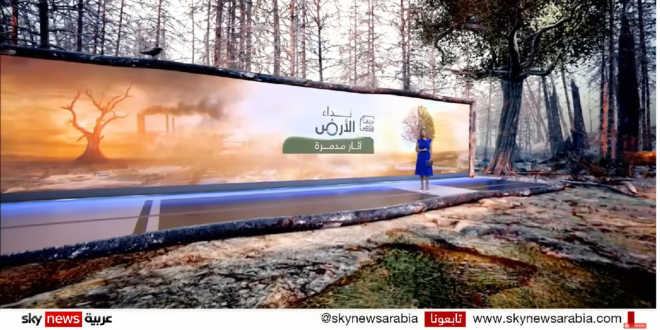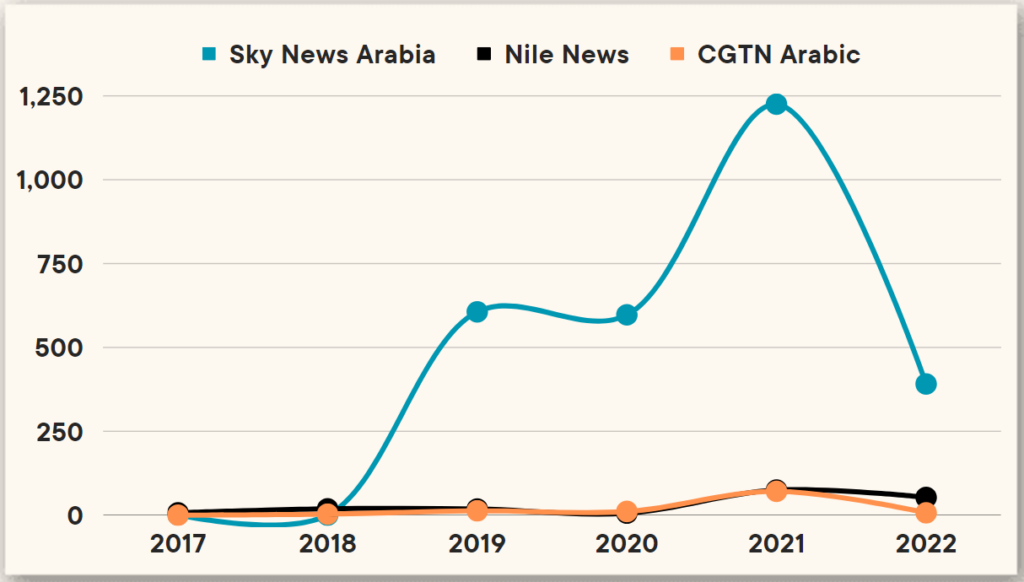Issue 34, summer/fall 2022
https://doi.org/10.70090/MAMA22FC
Abstract
The issue of climate change has imposed itself on the news media's agenda, especially after the United States' decision to abandon and then return to the 2015 Paris Climate Accord. The current study focuses on climate change framing on TV news websites; namely, Nile News, Sky News Arabia, and CGTN Arabic. This was done using quantitative content analysis using framing theory. News coverage has varied in terms of publication rates on climate change (Sky News= 2820; Nile News= 178; CGTN Arabic= 105). Results indicated that attribution of responsibility, disaster, political struggle, and economic consequence frames dominated the news coverage of climate change during the sampling period. The results also showed the United States and China as the most mentioned countries in the news coverage of climate change. The current study can be added to literature that examines the coverage of environmental issues in the news media. In addition, it opens horizons about research on media coverage of climate change and its effects on peoples.
Introduction
The Intergovernmental Panel on Climate Change (IPCC) has released three Special Reports as part of its Sixth Assessment Cycle, all of which emphasize the growing threat of climate change and the implications for more ambitious mitigation actions at all scales (Grubb 2022). In the Arab world, the climate mainstreaming session for green economic recovery in the Arab region, as part of the activities of Middle East and North Africa Climate Week 2022, called for "a need for balanced climate finance to support more stringent climate action" (MENA Climate Week 2022). Climate change has emerged as one of the most important issues facing humanity. The 2015 Paris Agreement secures climate financing for developing nations and offers a global framework for reaching a carbon-neutral future (Atwoli, Erhabor, Gbakima et al. 2022). However, the United States withdrew from the Agreement in 2019 citing the unfair economic burden placed on American workers, businesses, and taxpayers (UN 2019).
Since the mid-2000s, the number of research studies examining news media and online depictions of climate change has expanded (Schäfer and Schlichting 2014). Work on "framing" has been particularly important among these studies, in accordance with the concept's overall relevance in media and communication research. Framing refers to communicative sense-making processes in which certain parts of reality are highlighted while others are downplayed (Schäfer and O’Neill 2017). According to framing theory, the process of framing issues goes through two stages. The first is to build the frame through the media. The second is the process of public evaluation of this frame used in the media. In the context of framing societal issues and events on television channels, the literature indicates the emergence of some main frames, including the responsibility frame, the conflict frame, the economic consequences frame, the human-interest frame, and the ethical frame (Semetko and Valkenburg 2000). Social media uses a number of frames to communicate the issue of climate change such as: “morality and ethics”, “hopeful”, “motivational”, and “prognostic” (Molder et al 2021).
Researchers note several reasons for the lack of public awareness of climate change, as it lies outside the realm of regular life, an uncertain and distant future unrelated to everyday life (Zeng 2022; Neverla and Schäfer 2012; Moser 2009; Gifford 2008; Moser and Dilling 2007). This perception of climate change by some people as a distant problem will inevitably have a negative impact on future generations (Leiserowitz et al. 2011). Cameron et al. (2021) found that while using video as a climate visual is beneficial, using a series of climate maps is less effective and less understood by audiences. They believe that video is a superior medium of communication for audiences with little awareness or concern about climate change, and that in the future, these individuals and communities will be better able to interpret more complicated resources such as climate projection maps. As a result, it's crucial to comprehend how people utilize social media to talk about climate change.
Recently, climate change has become a point of focus for most mass media, especially TV news channels and social media and they have become the main sources of information about climate change (Luqman 2021; Engblom et al. 2019), and the evolution in the framing of climate change over proximal periods (Chen et al. 2022). Kuckartz (2007) argues that the news media is the central "interpretive system" of modern societies. Therefore, framing the news of societal issues is a necessity towards creating social change, especially when dealing with challenges of a social and political nature, such as the issue of climate change (Snow 2013; Benford and Snow 2000). However, the issue of climate change has not created a “hot crisis” like other environmental crises, which has led to erratic news coverage (McAllister et al. 2018). Still, 57% of Americans say they hear about climate change in the media at least monthly (Leiserowitz et al. 2021).
There is a marked advantage for the news media in setting the climate policy agenda in developed countries compared to developing countries (Pandey and Kurian 2017). Pinter and Ash (2012) examine media coverage of climate skepticism in the US, UK, Brazil, China, France and India and find that news coverage of skepticism is primarily limited to the US and UK, and they also find that media coverage of climate change is not comprehensive in the emerging economies of Brazil, Russia, China, and India, despite the pivotal roles these countries play in international climate change policy negotiations.
The way in which news media present stories about environmental disasters such as climate change, oil spills, flood hazards, and water conflict can have an impact on the public interpretation of policies and management actions (Cannon et al. 2020). This study attempts to shed light on the framing of climate change, problems related to it, and the volume of Arab and international interest in this thorny issue on Nile News, Sky News Arabia, and CGTN Arabic websites, by analyzing the content of news related to the climate change since the beginning of 2021 to mid-2022.
Literature Review
Climate change coverage in the news media declined by 23% in 2020 compared to 2019, owing to widespread coverage of the Covid-19 pandemic (Strauss et al. 2022). According to a survey of 40 nations, the media is the most extensively utilized information source on climate change, particularly when consumed via television or major news organizations' internet news websites (Newman et al. 2020). Analysis by Belotti et al. (2021) shows that the Fridays For Future movement believes climate activism is their own battle and social media is their battleground, and this reflects how much generations are empowered by digital climate activism. Molder et al. (2021) demonstrate how climate change is expressed on social media by young activists, and how they frame climate change as a moral and ethical issue. The study by Arcila-Calderón et al. (2015) examines how Spanish-language online media frames news concerning climate change, they conducted a quantitative content analysis of 889 news items from 97 online media outlets, the findings revealed that politicians are the primary sources, with nearly half of the news items coming from news wire services, and the analysis also revealed a link between the quoted source and the news frame.
Feldman et al. (2011) studied three major cable news channels' climate change coverage and assessed the link between viewership and global warming opinions. A content study of climate change coverage on Fox News, CNN, and MSNBC in 2007 and 2008 shows that Fox is more dismissive of climate change than CNN and MSNBC. A study by Stecula and Merkley (2019) explores three main frames in news coverage of climate change: the economic costs and benefits associated with climate mitigation, appeals to market values and principles, and the risks of climate change while framing climate mitigation in terms of probable solutions increases support for climate action (Spence and Pidgeon 2010). It is noticeable that coverage of climate change is increasing in most countries around the world, but the levels of news coverage of climate change vary between developed and developing countries, in the carbon-dependent countries that have obligations under the Kyoto Protocol, the media attention is very intense (Schmidt, Ivanova, and Schäfer 2013). The purpose of Pandey and Kurian’s (2017) research is to look at how elite newspapers in four major greenhouse gas emitting countries—the United States, the United Kingdom, China, and India—cover climate change issues, findings demonstrate that while these publications in impoverished countries utilize similar framing, there are considerable differences in framing in wealthy countries and across developed and developing countries, while the great majority of these news pieces and the frames they use in impoverished countries are linked to local institutional attitudes, news frames in wealthy countries are more diversified.
Solikhah and Subowo (2020) studied the relationship between financial performance and media coverage related to the quality of environmental disclosures, and the findings revealed that media attention had a considerable beneficial impact on the quality of environmental disclosures, whereas profitability had no influence. Environmental media coverage, both favorable and negative, has a positive association with the quality of voluntary environmental disclosure (Rupley, Brown, and Marshall 2012). León and Erviti (2013) believe that emotive portrayals of climate change may boost public engagement while simultaneously deflecting attention away from the issue, and that television news may make advantage of the visual effect that photos may have, but that the obligation to use photographs may be a drawback at times, their findings suggest that the lower rate of news coverage of climate change could be related to the dearth of attractive images available for television channels. Espinar Ruiz and Samuelsson (2012) studied 138 items of news connected to the environment and nature from a sample of 84 news programs broadcast by the three Spanish television networks, they found that news tends to concentrate on individual occurrences and favors emotional content, entertainment, or anecdotal information above explanations of solutions, repercussions, and causes.
Das (2020) investigates how climate justice was portrayed in three Indian newspapers during the COP21, COP22, and COP23 summits. The study uses information from selected Indian news outlets to demonstrate that during international climate discussions, publications emphasized harm prevention justice when an emphasis on the burden-sharing aspect was expected. The publications criticize wealthier countries' emissions but are less severe on local governments, who are responsible for decreasing pollution and emissions. The media have labeled India as a part of the Global South, describing it as a "single homogenous entity at risk from global climate change" (Billett, 2010:13). In the news coverage of haze the dominant trend was the neutral trend, focusing mainly on frames to "define problems" and "suggest remedies" (He, Zhang, and Chen 2020). Lin (2019) conducted a web study of online communication in Singapore during the haze crisis using a mixed method approach, and web analytics indicated that Singapore's murky online discourse took place mostly on Twitter, with the bulk of tweets being critical, also, according to textual analysis results, the majority of traditional media-affiliated news provided informed smog reporting and highlighted favorable government and authority metrics. Hopke (2020) tests the widely held belief that media coverage of heat waves and wildfires does not include any mention of climate change. From 2013 to 2018, the change in English-language media coverage is evaluated, comprising 37 news outlets from five nations, during the years analyzed, elite, climate-specialist news outlets paid more attention to climate problems in both heat wave and wildfire reporting, and there was an increase in media coverage of heat waves from 2013 to 2018, notably in Chinese English-language media. Painter (2016) looks at how the three IPCC Working Group reports from 2013 and 2014 were covered on television in five European countries: Germany, Norway, Poland, Spain, and the United Kingdom, and through the analysis of news, Four frames have dominated coverage of climate change: (disaster, uncertainty, explicit risk, and opportunity), and the results showed that the “disaster” frame was the strongest among all the frames, the “opportunity” frame came in second, while the “uncertainty” frame came in the third, and the “explicit risk” frame was hardly present.
In the context of climate change and public health. According to Hmielowski et al. (2013), confidence in scientists modulates the influence of news media consumption on global warming beliefs. The study by Stoddart et al. (2017) focuses on mediatized environmental conflict in Canada, and its impact on the role media visibility plays in amplifying the political efficacy of social movements in other national contexts. Findings demonstrate that mediated visibility in communication networks does not necessarily translate into power within policy networks, and this has significant implications for understanding climate change politics in other national contexts. Linnenluecke and Marrone (2021) examine 512 Australian newspaper articles published between 2016 and 2021 that report on air pollution caused by bushfire smoke and the resulting human health effects. They examine the extent to which these articles provide information on the possible range of negative health effects caused by bushfire smoke pollution, as well as the extent to which they report on climate change as a driver of increased bushfire risk. Weathers and Kendall (2016) investigated media depictions of climate change in US newspapers from January 1, 2007 to December 31, 2008 and found that the overall number of news stories discussing climate change decreased while the focus on the public health aspect of climate change rose. However, the most utilized general news frames (i.e., dramatic/substantive) did not differ much across the two time periods. While climate change has received widespread media attention, less attention has been paid to issues of climate justice, such as migration. When climate change migration fronts news coverage, it was often associated with frames of security, risk, and fear rather than measures to mitigate vulnerability to the consequences of climate change (Sakellari 2021).
Schäfer and Painter (2020) introduce the concept of climatic journalism, or the production of climate-related news, and explain how the organizational inclusion of climate journalism is changing, with a decrease in the number of correspondents and specialized correspondents working under more difficult conditions, as well as the emergence of online news media and specialized website that focus on climate news. They point out that there are significant variances between nations in the global north and those in the global south, as well as the fact that some types of internet players with exceptional climate coverage have emerged. Strauss et al. (2022) has offered valuable insights into the attitudes, perceptions, and motivations of journalists in Europe when covering extreme weather events like the 2019 European heatwaves. The results provided important information for journalism practices on how to improve climate change reporting and better align it with scientific explanations. Sekki’s (2020) study showed that there was interest in the issue of climate change at the blog of the World Organization for the Protection of the Environment (OMPE) during 2017 and 2018, but this attention was insufficient compared to the seriousness of climate change, and the magnitude of the negative effects that result from climate change and occur at an accelerating pace. Also, Sekki (2017) emphasizes the importance of blogs in addressing climate change, despite the topic of climate change sweeping TV channels, radio stations, newspaper headlines and social media.
In the Arab region, studies focused on environmental issues in general in the news media and the levels of environmental awareness among the public and did not focus on researching climate change. Alhuzami (2022) indicated a high impact of social media in spreading environmental awareness. Othman (2022) showed weakness in media coverage of environmental issues compared to political issues (16.5%, 69%). The Arab news media's neglect of coverage of environmental issues compared to political issues is attributed to achieving a media scoop on the one hand, and the weak financial support provided by the environmental authorities to the news media on the other (Hussein and Abderahman 2016). This research makes many theoretical and practical contributions to the literature on climate change in the Arab news media. Most of all, it is the first to systematically analyze the framing of climate change in the Arab media along the lines of Western research's interest in global climate.
The purpose of this study is to explore how TV news websites provided information about climate change for five years from 2017 to mid-2022. To achieve this goal, the following questions were posed:
RQ1: What are the rates of publication on climate change on TV news websites from 2017 to mid-2022?
RQ2: What news frames have TV news websites used to cover climate change?
RQ3: What are the active forces that have appeared in TV news websites' coverage of climate change?
Method
Measurement
This study employs quantitative content analysis, a research method for extrapolating conclusions from information to address questions in research (Krippendorff 2018). The news frames (Table 1) were identified in this study after reviewing existing literature.
Table 1
Description of frames in the study
| Frame | Description | Definition Sources |
|---|---|---|
| Disaster | It focuses on the expected severe impacts of climate change that threaten all aspects of life. It underscores the amplification of impacts with the lack of proper preparation by governments. Shows that disaster is occurring. | (Molder et al. 2022, O’Neill et al. 2015) |
| Human-Interest | It focuses on “Does the news story contain visual information that might generate feelings of outrage, empathy caring, sympathy, or compassion?” | (Semetko 2000) |
| Political Struggle | It focuses on the actions and measures that governments and peoples must take to confront climate change | (O’Neill et al. 2015) |
| Solutions | It Focuses on “Does the story suggest solution(s) to the problem/issue?” | (Semetko 2000) |
| Moral and Ethics | It focuses on an urgent moral, ethical or religious call, and the need to protect the most vulnerable. | (Molder et al. 2022, O’Neill et al. 2015) |
| Attribution of Responsibility | It focuses on “Does the news story suggest that some level of the government is responsible for the issue/problem?” | (Semetko 2000) |
| Settled Science | It focuses on the science of climate change, and the talk of scientists and experts to eliminate doubt and uncertainty, and the necessity of action in the face of climate change. | (Molder et al. 2022, O’Neill et al. 2015) |
| Economic Consequences | It discusses the potential impacts of climate change on the economy and investments, markets and potential economic actions (for example, divestment). | (O’Neill et al. 2015) |
| The Conflict | It focuses on “Does the news story reflect disagreement between parties/individuals/groups?” | (Semetko 2000) |
| Heath | It focuses on framing climate change as a threat to human health, resulting in health problems such as asthma, allergies, malnutrition and other health problems. | (Molder et al. 2022, O’Neill et al. 2015) |
| Hope | “The primary focus and tone of the post includes hope, defined as “yearning for better and believing the wished-for improvement is possible” | (Molder et al. 2022, Lazarus 2006) |
Data
Data were collected using the keyword “climate change” in the research process. For the CGTN Arabic website, the count was done manually after the search process because the website does not allow searching for a specific date. As for the Nile News and Sky News Arabia websites, they provide the ability to set the date. The CGTN Arabic website was chosen because China is the world's largest carbon emitter (recently surpassing the United States), and therefore China has made several efforts to address the threat of climate change in the future. The selection of the Sky News Arabia website is to represent the Western point of view on the issue of climate change. Finally, the Nile TV website was chosen to represent both the Egyptian and, to some extent, African position on the issue of climate change, especially considering Egypt's organization of the 27th UN Climate Change Conference (COP27). After the data was collected, it was entered into Microsoft Excel to calculate descriptive statistics.
Findings
RQ1: What are the rates of publication on climate change on TV news websites from 2017 to mid-2022?
The news in this study (n = 3031) from 2017 to mid-2022, and the first beginnings of publishing about climate change were in 2017 on the websites of the selected TV news (Sky News Arabia, Nile News, CGTN Arabic). Sky News has outperformed the other two websites in covering climate change, as the number of news it published during the five years was (n=2820), while the number of news published by Nile News was (n= 178) in the same time period. CGTN Arabic website published (n=105) news items. Figure 1 shows the rise in news coverage of climate change in 2021 (n= 1225) stories in Sky News Arabia, (n=75) stories in Nile News, (n=71) stories in CGTN. Next came the year 2019 in terms of the interest of selected TV channel websites in climate coverage, where Sky News Arabia published (n= 606) news, Nile News published (n=18) news, and CGTN published (13) news. News coverage of climate change did not differ much in 2020 from 2019, when the amount of news about climate change converged, which amounted to (n= 597) stories on Sky News Arabia, (n= 6) news on CGTN Arabic, and (n= 11) news in Nile news website. While the news coverage of climate change in the years 2017 and 2018 decreased in the websites of the three TV channels in the current study sample.
Figure 1
Frequency of news about climate change from 2017 to mid-2022.
RQ2: What news frames have TV news websites used to cover climate change?
Table 2 answers the second question of the study, where the most common frame for covering climate change during the analysis period was attribution of responsibility (n = 360, 11.6%). Disaster frame was ranked second (n= 356, 11.5%). Political struggle was the third most common news frame on which climate coverage on the three websites relied (n= 333, 10.7%), followed by the Economic Consequences frame in the fourth rank (n= 313, 10.1%). In fifth rank came the frame of Solutions (n= 309, 10%). The remaining frames came with fewer frequencies: Moral and Ethics (263, 8.5%), Settled Science (n= 254, 8.2%), Conflict (n= 238, 7.7%), Health (n= 228, 7.4%), Human- Interests (n= 27, 7.3%), and Hope (n= 222, 7.2%).
Table 2
Frequency of frames used in climate change news.
| Sky News Arabia | Nile News | CGTN Arabic | Total | |
| Disaster | 321(11.4%) | 23(12.9%) | 12(11.4%) | 356(11.5%) |
| Solutions | 287(10.2%) | 13(7.3%) | 9(8.6%) | 309(10%) |
| Political Struggle | 307(10.9%) | 19(10.7%) | 7(6.7%) | 333(10.7%) |
| Moral and Ethics | 241(8.5%) | 11(6.2%) | 11(10.5%) | 263(8.5%) |
| Settled Science | 231(8.2%) | 16(9%) | 7(6.7%) | 254(8.2%) |
| Attribution of Responsibility | 331(11.7%) | 14(7.9%) | 15(14.3%) | 360(11.6%) |
| Health | 208(7.4%) | 11(6.2%) | 9(8.6%) | 228(7.4%) |
| Economic Consequences | 279(9.9%) | 21(11.8%) | 13(12.4%) | 313(10.1%) |
| The Conflict | 209(7.4%) | 23(12.9%) | 6(5.7%) | 238(7.7%) |
| Hope | 201(7.1%) | 14(7.9%) | 7(6.7%) | 222(7.2%) |
| Human-Interest | 205(7.3%) | 13(7.3%) | 9(8.6%) | 227(7.3%) |
| Total | 2820 | 178 | 105 | 3103 |
RQ3: What are the active forces that have appeared in TV news websites' coverage of climate change?
Table 3 indicates the active forces in the selected TV news websites' coverage of climate change. The United States has emerged as the most powerful player in climate change news (1126, 34.9%). China ranked second as CGTN focused on China's responsibility to find solutions on climate change (258, 8%). Paris ranked third in coverage of climate news that focused on the 2015 Paris Agreement (256, 7.9%). Egypt ranked fourth, as the Nile News website focused on the efforts made by the Egyptian government to confront this phenomenon (209, 6.5%). IPCC ranked fifth because it is the body that prepares climate change reports periodically (155, 4.8%). The remaining forces in climate change news coverage are ranked: Britain (137, 4.2%), and its news centered on the Glasgow Climate Summit (COP26). Emirates (130, 4%), Sky News website focused on its efforts to confront this phenomenon. India (120, 3.7%), the news called for the world to unite in the face of climate change. United Nations (119, 3.6%), The news showed the efforts made by the United Nations in coordinating between countries to confront the threat of climate change. European Union (109, 3.4%), Italy (89, 2.8%), Saudi Arabia (84, 2.6%), World Health Organization (83, 2.5%), The Middle East (69, 2.1%), Developing countries (63, 2%), Gulf countries (43, 1.3%), Spain (41, 1.2%), Africa (32, 1%), and the other active forces got low frequencies.
Table 3
Frequency of the active forces in news coverage of climate change
| Sky News Arabia | Nile News | CGTN Arabic | Total | |
| United State | 1087(38.2%) | 21(10%) | 18(10.7%) | 1126(34.9%) |
| China | 178(6.3%) | 17(8.1%) | 63(37.5%) | 258(8%) |
| Egypt | 121(4.3%) | 81(38.8%) | 7(4.2%) | 209(6.5%) |
| IPCC | 151(5.3%) | 2(1%) | 2(1.2%) | 155(4.8%) |
| United nations | 111(3.9%) | 5(2.4%) | 3(1.8%) | 119(3.6%) |
| Paris | 251(8.8%) | 5(2.4%) | 0(0%) | 256(7.9%) |
| Emirates | 117(4.1%) | 7(3.3%) | 6(3.6%) | 130(4%) |
| Britain | 115(4%) | 13(6.2%) | 9(5.4%) | 137(4.2%) |
| Saudi Arabia | 77(2.7%) | 6(2.9%) | 1(0.6%) | 84(2.6%) |
| European Union | 102(3.6%) | 3(1.4%) | 4(2.4%) | 109(3.4%) |
| Italia | 81(2.8%) | 2(1%) | 6(3.6%) | 89(2.8%) |
| Gulf countries | 42(1.5%) | 1(0.5%) | 0(0%) | 43(1.3%) |
| The Middle East | 57(2%) | 7(3.3%) | 5(3%) | 69(2.1%) |
| Jordan | 19(0.7%) | 2(1%) | 0(0%) | 21(0.8%) |
| Iraq | 11(0.4%) | 0(0%) | 3(1.8%) | 14(0.4%) |
| Spain | 33(1.2%) | 3(1.4%) | 5(3%) | 41(1.2%) |
| Africa | 21(0.7%) | 7(3.3%) | 4(2.4%) | 32(1%) |
| India | 101(3.5%) | 9(4.3%) | 10(6%) | 120(3.7%) |
| Developing countries | 47(1.7%) | 8(3.8%) | 8(4.8%) | 63(2%) |
| World Health Organization | 71(2.5%) | 7(3.3%) | 5(3%) | 83(2,5%) |
| Israel | 13(0.4%) | 2(1%) | 3(1.8%) | 18(0.6%) |
| Greenpeace | 15(0.5%) | 0(0%) | 3(1.8%) | 18(0.6%) |
| Turkey | 9(0.3%) | 0(0%) | 1(0.6%) | 10(0.3%) |
| The World Bank | 17(0.6%) | 1(0.5%) | 2(1.2%) | 20(0.7%) |
| Total * | 2847 | 209 | 168 | 3224 |
* Note: The total increased because some news contains more than one active force.
Discussion and Conclusion
The current study explores the framing of climate change in TV news websites. After examining (n= 3103) news stories, we found that climate change is presented as an issue that must receive the attention and responsibility of everyone around the world, both people and governments. In the first research question we explain the volume and rates of publication on climate change. Nearly five years of news were included in the study. The most news was published in 2021 and 2019. While the number of news fluctuated from year to year, the number of news appeared to be trending upward. Fewer than 30 news stories were published in 2017 and 2018. Then, in 2019, 637 news articles were published. This may be linked to environmental events or international attention on the problem for other reasons. After tracking the coverage of all environmental news topics on Swedish TV between 1961 and 2010, Djerf-Pierre (2012) found a significant association between interest levels in various environmental problems.
The high rates of publication on climate change on selected TV news websites during the previous year and the current year can be justified by the fact that the issue of climate change has become a central issue towards which most countries have turned. There is a difference between the Sky News Arabia website and the other two websites in terms of publication rates that may be due to the channel's technical capabilities and also the amount of attention it pays to the issue of climate change. The rise in climate change news on the Nile News website can be explained by Egypt's hosting of the 27th session of the United Nations Climate Change Conference (COP27). The publication of the CGTN Arabic website on climate change also began in the context of China's keenness, as a pivotal country and economic power, in mitigating the threat of climate change, especially reducing carbon emissions as evidenced by their participation in several international climate agreements.
The second research question determined which frames where most popularly used for news stories related to climate change. The frame of attribution of responsibility appeared in coverage of climate change on the websites of the selected TV news, as the news coverage adopted a new discourse after the 2015 Paris Agreement, urging all countries, governments, and peoples to take their responsibility in facing the effects of climate change. In the same context, the coverage of CGTN Arabic was the keenest on highlighting China as a country that bears its responsibility to the world regarding climate change. Responsibility, conflict, economic consequences, and national attitude are the four prominent frames provided in news articles in both developed and developing nations, according to Pandey and Kurian’s (2017) textual analysis. While the disaster came in the second classification as the most common news frame, emphasizing the magnitude of the danger that climate change will pose in the near future, and that concerted efforts must be made to reduce the understanding of this disaster. The frame of the political struggle appeared in the coverage of Sky News Arabia and the Nile News websites, and through it emerged the role of some political systems and state governments in holding conferences and summits to discuss the issue of climate change and its future effects on peoples.
The Economic Consequences frame explains the negative effects of climate change on the economies of countries. Frames that focus on economic cost reduce support for climate change mitigation (Davis 1995; Vries et al. 2016). Global cooperation on climate change is necessary, making it a development opportunity to create new economic growth (He 2015). Environmental issues frequently take a backseat to worries about the economy, health, and crime in terms of public priorities and legislation (Molder et al. 2021). Despite the frequent employment of fear-based techniques by climate change advocates, most academics concur that these strategies are ineffective (Moser and Dilling 2011).
The solutions frame was present in Sky News Arabia's coverage of climate change by emphasis on taking effective measures and policies to reduce greenhouse gas emissions and make the environment more sustainable. The Nile News website indicated that Egypt launched the National Climate Change Strategy 2050. While CGTN Arabic website focused on China's progress in the Climate Change Index. Through analyzing the content analysis conducted by Sekki (2020), some of the posts were urgent calls and calls for decision makers to take action to combat climate change by enacting laws and taking certain measures such as adopting renewable energy and shifting towards a green economy and reducing dependence on the traditional energy systems.
The third research question shows the pivotal countries or the active forces in news coverage of climate change, and the emergence of the United States at the forefront of those countries as a driver of global events, especially after its announcement on November 4, 2019, to withdraw from the Paris Agreement on Climate Change, this led to an imbalance in the climate change file. And quickly, the United States formally returned to the Paris Climate Agreement on February 19, 2021, to galvanize the global fight against climate change. China was also present in the news coverage of climate change because it ranks first in the world in carbon emissions, so news coverage focused on China's efforts and commitment to reduce carbon emissions. China has announced its goal to reach peak carbon emissions by 2030 and achieve carbon neutrality by 2060, while moving towards the efficient use of clean energy to achieve these two aims. In China and India, national political interests and common but differentiated responsibilities are systematically linked to national positions, climate politics, and media coverage of climate issues, according to Pandey and Kurian (2017), while liberal and conservative newspapers in the United States and the United Kingdom adopt distinctly different political stances. The remaining countries gradually appeared in the coverage of the three TV news websites, showing the efforts made to tackle climate change.
 Arab Media & Society The Arab Media Hub
Arab Media & Society The Arab Media Hub






